
Welcome to Civil and Environmental Engineering
Civil and environmental engineers work to create a cooperative balance between building, monitoring, and maintaining the infrastructure of society and protecting human and environmental health. They plan, design, and build many civil works that make modern life possible.
The Department of Civil and Environmental Engineering at MSU offers undergraduate and graduate degrees using a robust design-build education. This high-quality experience is a perfect blend of theory and application. High-achieving students have opportunities for undergraduate research and pursuit of the dual B.S. - M.S. programs in civil engineering or environmental engineering. Sub-disciplines include environmental engineering, geotechnical engineering, pavements engineering, structural engineering, transportation engineering, and hydrology, and water resources.
612
Undergraduate Students
(Fall 2024)
119
Graduate Students
(Fall 2024)
182
Degrees Granted
(2023-2024)
$11M
Research Expenditure
(Fall 2023)
28
Tenure Faculty
(Fall 2023)
 Welcome to the Department of Civil and Environmental Engineering (CEE) at Michigan State University (MSU)! Civil and environmental engineers have led the development of the most sophisticated infrastructure systems in the world, including roads, bridges, buildings, and water distribution/treatment systems. Today, we are tasked with the challenge of maintaining and ensuring the long-term sustainability of these systems. To this end, MSU CEE are involved in cutting-edge work that has advanced these efforts. For example, we have installed thousands of tiny self-powered infrastructure sensors on the Mackinac Bridge, allowing for real-time monitoring and proactive bridge preservation and management. We are also using sensor technologies to monitor traffic congestion, building energy performance, and the transmission of COVID-19. The resultant data can then be used to plan, design, construct, operate, and maintain these systems.
Welcome to the Department of Civil and Environmental Engineering (CEE) at Michigan State University (MSU)! Civil and environmental engineers have led the development of the most sophisticated infrastructure systems in the world, including roads, bridges, buildings, and water distribution/treatment systems. Today, we are tasked with the challenge of maintaining and ensuring the long-term sustainability of these systems. To this end, MSU CEE are involved in cutting-edge work that has advanced these efforts. For example, we have installed thousands of tiny self-powered infrastructure sensors on the Mackinac Bridge, allowing for real-time monitoring and proactive bridge preservation and management. We are also using sensor technologies to monitor traffic congestion, building energy performance, and the transmission of COVID-19. The resultant data can then be used to plan, design, construct, operate, and maintain these systems.
Our department currently offers undergraduate and graduate degrees in both civil and environmental engineering. Our curricula provide a robust design-build education that trains students for their professional careers. This high-quality educational experience has a perfect blend of theory and application. High-achieving students have opportunities for undergraduate research and pursuit of the dual BS-MS programs in civil engineering or environmental engineering. Students have the opportunity to explore a variety of CEE disciplines, including energy/sustainability, environmental engineering, geotechnical/pavement engineering, structural engineering, transportation engineering, and hydrology/water resources. Our graduates are in high demand both in the public and private sectors. The placement rate within six months of graduation is above 90%. The undergraduate degree programs in civil and environmental engineering are accredited by the Engineering Accreditation Commission of ABET.
We also have excellent graduate programs and award M.S. and Ph.D. degrees in civil engineering and environmental engineering. Our outstanding faculty in partnership with both undergraduate and graduate students are engaged in innovative and impactful research in the areas of (i) resilient, sustainable materials and infrastructure; (ii) transportation safety, sustainability and mobility; (iii) sustainability and water resources systems modeling and (iv) environmental health and water quality engineering. The department hosts the National Center for Pavement Preservation, which leads collaboration among government agencies, industry, and academia to improve pavement preservation practices, as well as a US Department of Energy Industrial Assessment Center.
There is much more to learn about our department and its people, we have tried to make these pages quick and easy to use for a broad range of users. For more details on something in particular, please contact us at cee@egr.msu.edu or visit us in person to explore the possible educational and research opportunities that exist in the Department of Civil and Environmental Engineering.
Go Green!
Peter Savolainen
Chairperson and MSU Foundation Professor
Visit Undergraduate Admissions for information on applying to the program.
The Department of Civil and Environmental Engineering offers Bachelor of Science degrees in Civil Engineering and Environmental Engineering.
The civil engineering and environmental engineering programs are accredited by the Engineering Accreditation Commission of ABET.

Graduates are prepared for careers as professional engineers in consulting, public agencies, and industry as well as for the pursuit of advanced degrees. Both programs provide students with a broad foundation in the discipline in addition to the opportunity to delve deeper into specific areas of interest. The programs are designed to be completed in four years (128 credits), although students often obtain internships or study abroad, which may affect the time to degree. High achieving students (GPA ≥3.5) can also opt to do a “fast track” program in their senior year leading to a master’s degree with an additional 21 credits of coursework.
The B.S. degree program in civil engineering is flexible while providing both breadth and depth within the discipline. At MSU, all engineering students are engaged in engineering core courses starting in their freshman year, through the First-Year Engineering CoRe Experience. Civil engineering students take required courses in mechanics, materials, environmental engineering, fluid mechanics, geotechnical engineering, structures, and transportation that provide breadth. More depth in selected areas and flexibility is provided in the junior and senior years when students must take electives in at least four different areas—selected from environmental engineering, geotechnical engineering, structures, pavement engineering, transportation engineering, and water resources. Further specialization can be pursued in these areas. The program concludes with a senior-level comprehensive team-based capstone design course.
The B.S. program in environmental engineering provides both breadth and depth within the discipline in a well-structured framework. At MSU, all engineering students are engaged in engineering core courses starting in their freshman year through the First-Year Engineering CoRe Experience. Early on in environmental engineering, students take specific required classes in environmental engineering and water resources. More depth in selected areas and flexibility is provided in the junior and senior years. The program concludes with a senior-level comprehensive team-based design course.
Visit our Degrees and Programs page to learn about the Dual B.S./M.S.
The Department of Civil and Environmental Engineering offers Master of Science (M.S.) and Doctor of Philosophy (Ph.D.) degrees in both Civil Engineering and Environmental Engineering.
Visit Graduate Admissions for information on applying to the programs.
Civil Engineering
The M.S. program in civil engineering covers the essential advanced elements of the profession and prepares graduates for professional practice or continued study. It typically requires 2 years of study, with an option for a thesis or project. The Ph.D. program in civil engineering focuses on research, and typically involves at least 3 years of study beyond the MS. Applications are due December 31 for enrollment the following Fall (end of August). The M.S. program is also available online.
Civil engineering is the design and maintenance of public works such as roads, bridges, water and energy systems as well as public facilities like ports, railways and airports. (American Society of Civil Engineers). Civil engineers perform engineering duties in planning, designing, and overseeing construction and maintenance of building structures, and facilities, such as roads, railroads, airports, bridges, harbors, channels, dams, irrigation projects, pipelines, power plants, and water and sewage systems. Includes architectural, structural, traffic, ocean, and geotechnical engineers. (Bureau of Labor Statistics)
Environmental Engineering
The M.S. program in environmental engineering covers the essential advanced elements of the profession and prepares graduates for professional practice or continued study. It typically requires 2 years of study, with an option for a thesis or project. The Ph.D. program in environmental engineering focuses on research, and typically involves at least 3 years of study beyond the MS. Applications are due December 31 for study that begins the following Fall (end of August).
Environmental engineering is the application of scientific and engineering principles to assess, manage and design sustainable environmental systems for the protection of human and ecological health. (Association of Environmental Engineering and Science Professors)
Environmental engineers research, design, plan, or perform engineering duties in the prevention, control, and remediation of environmental hazards using various engineering disciplines. Work may include waste treatment, site remediation, or pollution control technology.
Employment of environmental engineers is projected to grow 22 percent from 2010 to 2020, faster than the average for all occupations. State and local government concerns regarding water should lead to efforts to increase efficiency of water use. (Bureau of Labor Statistics).
The CEE Department Professional Advisory Board provides valuable advice and guidance to the department to keep our programs and activities relevant to the profession. They also assist with lectures in our capstone senior design class with class components related to professionalism, ethics, management and similar topics.
Brandon Onan, P.E.
- Chairperson of PAB
- Lead and Copper Unit Supervisor
- EGLE-DWEHD
Peter Savolainen, Ph.D., P.E.
- Professor & Chairperson
- Dept. of Civil and Environmental Engineering
Heather Cheslek, P.E.
- Client Director and Sr Project Manager
- Black & Veatch
Carissa McQuiston, P.E.
- Michigan Department of Transportation
- Safety Programs Manager
Ian Clutten, P.E.
- Director of Preconstruction Services
- Granger
Doug Peters, P.E.
- President
- Christman Building Innovation Group
Peter A. Margules, P.E.
- Civil Engineer (Geotechnical)
- U.S. Army Corps of Engineers
Christine Pomeroy, PhD, PE
- Associate Professor
- University of Utah
Luke Smith
- Senior Project Manager
- Waste Management
Todd Sneathen, P.E.
- Vice President
- Hubbell, Roth & Clark, Inc.
Geneva Vanlerberg, P.E.
- District Engineer
- Drinking Water and Environmental Health Division
Matt Wendling, PE
- Senior Vice President
- WSP Michigan Inc.
Last updated in March 2025
Corporate Partners Program
Corporate Partners that support the MSU Department of Civil and Environmental Engineering play an important role in nurturing future industry leaders. They contribute to engineering research and help foster educational opportunities for students who are working hard to prepare for diverse careers in engineering and technology.
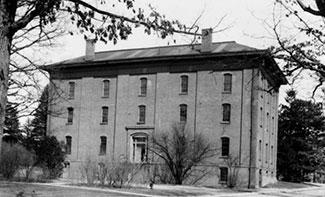
William A. Bradley, March 1986; Susan J. Masten, October 2014 (with special appreciation to Mackenzie Davis for his research published as part of the department's 100th anniversary in 2009)
All historic photos below (11) are courtesy of Michigan State University Archives and Historical Collections.
The Civil Engineering Department was established in 1909. However, it was very much a part of the school from its beginnings. The Agricultural College of the State of Michigan was created by the State Legislature in 1855 and in June of that year, a tract of 676.57 acres was purchased. During the next 2 years, College Hall, [photo at left], Saints’ Rest Dormitory, [photo right below], and a brick barn were built, and the college welcomed its first students on May 13, 1857.
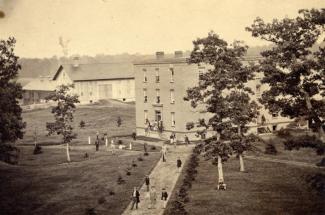 Four faculty members were hired; one of whom was Calvin Tracy, who was to teach mathematics and surveying. He was authorized to purchase a surveyor's compass and level "with the necessary equipment for surveying and leveling in the Agricultural College."
Four faculty members were hired; one of whom was Calvin Tracy, who was to teach mathematics and surveying. He was authorized to purchase a surveyor's compass and level "with the necessary equipment for surveying and leveling in the Agricultural College."
The 63 students attended classes in the mornings and worked three hours in the afternoon, felling trees, planting orchards, or hauling brick to build homes on Faculty Row, one of which (and the only one spared from demolition) was Cowles House, for the professors and their families and for some of the university’s first female students. 
Rural and Civil Engineering was one of the courses taken by seniors in the fixed curriculum. In 1861, T.C. Abbot, who later became the second president of the college, was appointed Professor of Rural and Civil Engineering, although his earlier and later designation was Professor of History and English Literature. In 1861, the college graduated its first class, but had no commencement, since the Civil War had started and six of the seven graduates had enlisted in a special company of engineers that was to serve under Major General John C. Frémont.
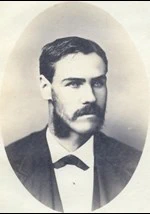
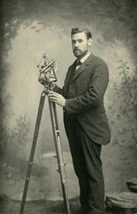 In his 1864 report, President Abbot recommended that a civil engineer be appointed to the Faculty of Instruction and in 1875, Mr. Rolla C. Carpenter an 1873 graduate of the college who also was a Civil Engineering graduate of Michigan University, was hired as instructor. Thus, the department of Mathematics and Civil Engineering was founded. Carpenter’s first class in Civil Engineering used Wood's revision of Mahan's Elementary Treatise on Civil Engineering studying the chapters on materials, strength of materials, framing, masonry, roads, canals, rivers, and bridges. During his fifteen years at the college, Prof. Carpenter taught classes in Civil Engineering and Mathematics, while serving the college in numerous other ways. He surveyed the grounds, supervised the steam works and the carpenter shop, designed and supervised the construction of a dam on the Red Cedar river (designing his own pile driver), designed the new Mechanical laboratory, supervised the manufacture of 400,000 bricks, designed a new bath house for students (with 10 tubs - photo below, right), taught French, and, in 1884, served as the coach of the somewhat loosely organized college football team.
In his 1864 report, President Abbot recommended that a civil engineer be appointed to the Faculty of Instruction and in 1875, Mr. Rolla C. Carpenter an 1873 graduate of the college who also was a Civil Engineering graduate of Michigan University, was hired as instructor. Thus, the department of Mathematics and Civil Engineering was founded. Carpenter’s first class in Civil Engineering used Wood's revision of Mahan's Elementary Treatise on Civil Engineering studying the chapters on materials, strength of materials, framing, masonry, roads, canals, rivers, and bridges. During his fifteen years at the college, Prof. Carpenter taught classes in Civil Engineering and Mathematics, while serving the college in numerous other ways. He surveyed the grounds, supervised the steam works and the carpenter shop, designed and supervised the construction of a dam on the Red Cedar river (designing his own pile driver), designed the new Mechanical laboratory, supervised the manufacture of 400,000 bricks, designed a new bath house for students (with 10 tubs - photo below, right), taught French, and, in 1884, served as the coach of the somewhat loosely organized college football team.
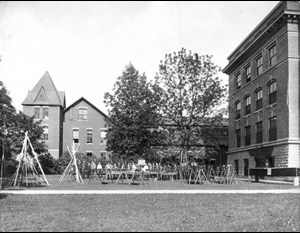 The Land Grant Act of 1862 had specified the teaching of "such branches of learning as are related to agriculture and the mechanic arts". Thus, in 1885, a two year course in Mechanic Arts was started. This soon expanded into a 4 year Mechanical course, which later became Mechanical Engineering. The same year, the first engineering building, the Mechanical Building, was constructed.
*Photo courtesy of Michigan State University Engineering Publications OfficeIn 1890, Professor Carpenter left for a position at Cornell University and after a year, Professor Herman K. Vedder, a civil engineering graduate of Cornell University with a Master's degree in Structural Engineering, was appointed as the Professor of Mathematics and Civil Engineering. Vedder continued to teach the courses in math and civil engineering and provide expertise to the college in its engineering work.*
The Land Grant Act of 1862 had specified the teaching of "such branches of learning as are related to agriculture and the mechanic arts". Thus, in 1885, a two year course in Mechanic Arts was started. This soon expanded into a 4 year Mechanical course, which later became Mechanical Engineering. The same year, the first engineering building, the Mechanical Building, was constructed.
*Photo courtesy of Michigan State University Engineering Publications OfficeIn 1890, Professor Carpenter left for a position at Cornell University and after a year, Professor Herman K. Vedder, a civil engineering graduate of Cornell University with a Master's degree in Structural Engineering, was appointed as the Professor of Mathematics and Civil Engineering. Vedder continued to teach the courses in math and civil engineering and provide expertise to the college in its engineering work.*
In 1890, Professor Carpenter left for a position at Cornell University and after a year, Professor Herman K. Vedder, a civil engineering graduate of Cornell University with a Master's degree in Structural Engineering, was appointed as the Professor of Mathematics and Civil Engineering. Vedder continued to teach the courses in math and civil engineering and provide expertise to the college in its engineering work.
 In 1892, the second Tau Beta Pi chapter in the nation was founded at the college.
In 1892, the second Tau Beta Pi chapter in the nation was founded at the college.
Campus life during these early years was not always easy; East Lansing was just a small village. Travel to Lansing was nearly impossible in the spring and fall, when the roads became mires of mud and the streetcar that later connected the town and the college had not yet been built.
Until the 1890's, college was in session in the spring, summer and fall so that the students could practice agriculture at the college during the growing season. Additionally, many of them depended on winter teaching jobs in the country schools for their expenses. When the academic calendar was changed to include winter classes, new problems were confronted. Professor Vedder, in his 1897 report to the college president, wrote, "allow me to urge the early installation of sanitary conveniences at College Hall", the change in terms "requiring long class-work in winter months, make this necessary." 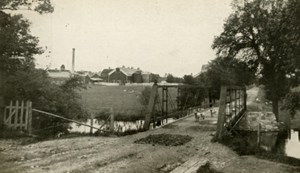
Since many of the engineering students planned for a Civil Engineering career, Professor Vedder, in 1901, expressed that "there is a demand for a course of study" allowing "specialization along Civil Engineering lines". On December 4, 1901, the governing board of the college approved the new option and seventeen members of the junior class elected civil engineering. "Topographical drawing and sketching, shadows and perspective, railroad surveying, bridge analysis and design, masonry, arches and pavements" were added to the department curriculum. On June 18, 1903, fourteen seniors became the first graduates from the Civil Engineering option.
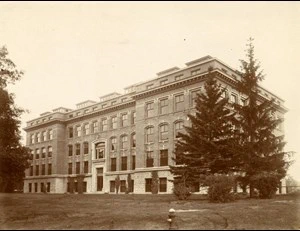 During the early years of this new option, the faculty was overly busy. Prof. Vedder repeatedly protested about the crowded class and laboratory facilities. In 1907, a new Engineering Hall, costing $110,000, was constructed to house the departments of Mechanical Engineering, Mathematics, and Civil Engineering, Drawing and Design, and Physics and Electrical Engineering. The same year, Engineering's first Dean, G.W. Bissell, was appointed, and in 1908, the Division of Engineering was established.
During the early years of this new option, the faculty was overly busy. Prof. Vedder repeatedly protested about the crowded class and laboratory facilities. In 1907, a new Engineering Hall, costing $110,000, was constructed to house the departments of Mechanical Engineering, Mathematics, and Civil Engineering, Drawing and Design, and Physics and Electrical Engineering. The same year, Engineering's first Dean, G.W. Bissell, was appointed, and in 1908, the Division of Engineering was established.
By 1908, of the 232 engineering students who graduated in the years after the Civil option was founded, 117 had completed the civil engineering option. Professor Vedder proposed that in order to best serve the students, civil engineering should be a separate department and on July 7, 1909, the Department of Civil Engineering was born.
Since that time, the transitions in the college and in Engineering have been many. In 1909, the State Agricultural College became the Michigan Agricultural College. Then in 1925, the name was changed to Michigan State College of Agriculture and Applied Science. In 1955, its one-hundredth year, the College became a University and finally, in 1964, it was renamed Michigan State University.
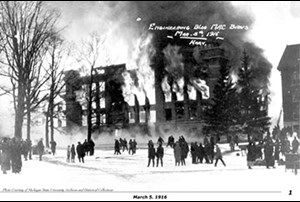 The first Engineering Hall burned in March of 1916 and was replaced by Olds Hall of Engineering, which housed most of the departments until 1962, when the present Engineering Building was completed. Civil Engineering became the Department of Civil and Sanitary Engineering in 1962 and the Department of Civil and Environmental Engineering in 1985. The department was housed in the Engineering Building from 1962 through 1981, when it was moved to the Communication Arts and Science Building where it remained until 1989 when the new wing of the Engineering Building was opened. In 1987, the Engineering Research Complex was opened, housing the environmental engineering faculty, graduate students, and laboratories. In 2002, the department dedicated the Civil Infrastructure Laboratory, located on Jolly Road in Okemos. The laboratory was expanded in 2005 to include a fire testing facility.
The first Engineering Hall burned in March of 1916 and was replaced by Olds Hall of Engineering, which housed most of the departments until 1962, when the present Engineering Building was completed. Civil Engineering became the Department of Civil and Sanitary Engineering in 1962 and the Department of Civil and Environmental Engineering in 1985. The department was housed in the Engineering Building from 1962 through 1981, when it was moved to the Communication Arts and Science Building where it remained until 1989 when the new wing of the Engineering Building was opened. In 1987, the Engineering Research Complex was opened, housing the environmental engineering faculty, graduate students, and laboratories. In 2002, the department dedicated the Civil Infrastructure Laboratory, located on Jolly Road in Okemos. The laboratory was expanded in 2005 to include a fire testing facility.
The department has continued to grow and evolve. The first Master of Science degree was awarded on June 18, 1928 to Howard Allen. His thesis topic was "The Design of a Reinforced Concrete Laboratory for the Department of Civil Engineering. The CE program was first accredited in 1937 by the Engineers Council for Professional Development, which has become ABET. An undergraduate curriculum in sanitary engineering was also offered, but discontinued in 1954 as it was believed that the programs did not offer sufficient breath. Almost sixty years later, In 2011, the B.S. Environmental Engineering program was approved by the State Board of Education. The first environmental engineering student graduated in December 2011 and the program was accredited in August 2012. Graduate degrees in environmental engineering were first offered in 1980.
The civil and environmental engineering programs at MSU have always been student-focused, from 1900, when Professor Herman Klock Vedder expressed a need for a course of study "allowing for specialization along the Civil Engineering Lines" to today when student groups such as American Society of Civil Engineers (ASCE) Student Chapter, Chi Epsilon, and Environmental Engineering Society flourish, undergraduate and graduate students work together with faculty and postdoctoral assistants to solve complex problems, and students are encouraged to actively participate in the classroom. The Student Chapter of the ASCE has been active at MSU since 1921. Chi Epsilon, the National CE Honor Society was installed as chapter 42 in 1951 and the Environmental Engineering (Student) Society was founded as a chapter of the Air and Waste Management Association in 1988. The MSU chapter of Chi Epsilon has twice hosted the Chi Epsilon National Conclave, in 1958 and in 1986.
 Student Chapters have distinguished themselves as being first in a number of arenas. The first ASCE sponsored National Concrete Canoe Competition was held in 1988 at MSU, with canoe races at Lake Lansing. The first National Student Steel Bridge competition was held at MSU in 1992, and the Spartans became the first national champions. MSU's concrete canoe team, the Rowing Stone, took first place in the National Concrete Canoe Competition in 1990 in Buffalo, NY. The Environmental Engineering (Student) Society took first place at the Waste-Management Education and Research Consortium International Competitions in 1994 and 1995. The EES team took first place at the Air and Waste Management Association sponsored Environmental Competition International (ECi) in 2015.
Student Chapters have distinguished themselves as being first in a number of arenas. The first ASCE sponsored National Concrete Canoe Competition was held in 1988 at MSU, with canoe races at Lake Lansing. The first National Student Steel Bridge competition was held at MSU in 1992, and the Spartans became the first national champions. MSU's concrete canoe team, the Rowing Stone, took first place in the National Concrete Canoe Competition in 1990 in Buffalo, NY. The Environmental Engineering (Student) Society took first place at the Waste-Management Education and Research Consortium International Competitions in 1994 and 1995. The EES team took first place at the Air and Waste Management Association sponsored Environmental Competition International (ECi) in 2015.
Not only on campus, but throughout the state and abroad, civil engineering has clearly left its mark. By far the greatest contribution of civil engineers along the banks of the Red Cedar has been in the education of thousands of men and women, who have obtained Bachelors, Masters, and Doctorate degrees, and have become involved throughout the world in the creation of engineering projects, the improvement of civil infrastructure and society, and in the education of our future generations of engineers and scientists.Photo of Engineering students at commencement
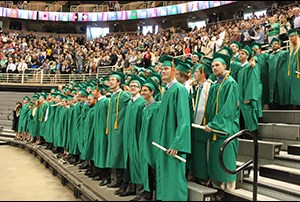 References
References
- Annual Reports of the State Board of Agriculture, 1862-1957. These contain faculty listings, financial statements and annual reports of each of the departments of the college.
- Beal, William J., History of the Michigan Agricultural College, East Lansing, Michigan, 1915.
- Dunbar, Willis F., Michigan Institutions of Higher Learning in the Civil War, published by the Michigan Civil War Centennial Observance Commission, Lansing, 1964
- Dunbar, Willis F., The Michigan Record in Higher Education, Wayne University Press, Detroit, 1963.
- Kuhn, Madison and Blair, Lynn, A Short History of Michigan State, Michigan State College Press, East Lansing, 1955.
- Kuhn, Madison, Michigan State, the First Hundred Years, East Lansing, 1955.
- Blaisdell, Thomas C., ed., Semi-Centennial Celebration of Michigan State Agricultural College, East Lansing, 1908. This book contains the complete program of the celebration, held May 26, 29-31, 1907.
- Murray, Fran, Notes on Civil Engineering department history, 1985.
- All historic photos above (first 11) are courtesy of Michigan State University Archives and Historical Collections.

William A. Bradley, March 1986; Susan J. Masten, October 2014 (with special appreciation to Mackenzie Davis for his research published as part of the department's 100th anniversary in 2009)
All historic photos below (11) are courtesy of Michigan State University Archives and Historical Collections.
The Civil Engineering Department was established in 1909. However, it was very much a part of the school from its beginnings. The Agricultural College of the State of Michigan was created by the State Legislature in 1855 and in June of that year, a tract of 676.57 acres was purchased. During the next 2 years, College Hall, [photo at left], Saints’ Rest Dormitory, [photo right below], and a brick barn were built, and the college welcomed its first students on May 13, 1857.
 Four faculty members were hired; one of whom was Calvin Tracy, who was to teach mathematics and surveying. He was authorized to purchase a surveyor's compass and level "with the necessary equipment for surveying and leveling in the Agricultural College."
Four faculty members were hired; one of whom was Calvin Tracy, who was to teach mathematics and surveying. He was authorized to purchase a surveyor's compass and level "with the necessary equipment for surveying and leveling in the Agricultural College."
The 63 students attended classes in the mornings and worked three hours in the afternoon, felling trees, planting orchards, or hauling brick to build homes on Faculty Row, one of which (and the only one spared from demolition) was Cowles House, for the professors and their families and for some of the university’s first female students. 
Rural and Civil Engineering was one of the courses taken by seniors in the fixed curriculum. In 1861, T.C. Abbot, who later became the second president of the college, was appointed Professor of Rural and Civil Engineering, although his earlier and later designation was Professor of History and English Literature. In 1861, the college graduated its first class, but had no commencement, since the Civil War had started and six of the seven graduates had enlisted in a special company of engineers that was to serve under Major General John C. Frémont.

 In his 1864 report, President Abbot recommended that a civil engineer be appointed to the Faculty of Instruction and in 1875, Mr. Rolla C. Carpenter an 1873 graduate of the college who also was a Civil Engineering graduate of Michigan University, was hired as instructor. Thus, the department of Mathematics and Civil Engineering was founded. Carpenter’s first class in Civil Engineering used Wood's revision of Mahan's Elementary Treatise on Civil Engineering studying the chapters on materials, strength of materials, framing, masonry, roads, canals, rivers, and bridges. During his fifteen years at the college, Prof. Carpenter taught classes in Civil Engineering and Mathematics, while serving the college in numerous other ways. He surveyed the grounds, supervised the steam works and the carpenter shop, designed and supervised the construction of a dam on the Red Cedar river (designing his own pile driver), designed the new Mechanical laboratory, supervised the manufacture of 400,000 bricks, designed a new bath house for students (with 10 tubs - photo below, right), taught French, and, in 1884, served as the coach of the somewhat loosely organized college football team.
In his 1864 report, President Abbot recommended that a civil engineer be appointed to the Faculty of Instruction and in 1875, Mr. Rolla C. Carpenter an 1873 graduate of the college who also was a Civil Engineering graduate of Michigan University, was hired as instructor. Thus, the department of Mathematics and Civil Engineering was founded. Carpenter’s first class in Civil Engineering used Wood's revision of Mahan's Elementary Treatise on Civil Engineering studying the chapters on materials, strength of materials, framing, masonry, roads, canals, rivers, and bridges. During his fifteen years at the college, Prof. Carpenter taught classes in Civil Engineering and Mathematics, while serving the college in numerous other ways. He surveyed the grounds, supervised the steam works and the carpenter shop, designed and supervised the construction of a dam on the Red Cedar river (designing his own pile driver), designed the new Mechanical laboratory, supervised the manufacture of 400,000 bricks, designed a new bath house for students (with 10 tubs - photo below, right), taught French, and, in 1884, served as the coach of the somewhat loosely organized college football team.
 The Land Grant Act of 1862 had specified the teaching of "such branches of learning as are related to agriculture and the mechanic arts". Thus, in 1885, a two year course in Mechanic Arts was started. This soon expanded into a 4 year Mechanical course, which later became Mechanical Engineering. The same year, the first engineering building, the Mechanical Building, was constructed.
*Photo courtesy of Michigan State University Engineering Publications OfficeIn 1890, Professor Carpenter left for a position at Cornell University and after a year, Professor Herman K. Vedder, a civil engineering graduate of Cornell University with a Master's degree in Structural Engineering, was appointed as the Professor of Mathematics and Civil Engineering. Vedder continued to teach the courses in math and civil engineering and provide expertise to the college in its engineering work.*
The Land Grant Act of 1862 had specified the teaching of "such branches of learning as are related to agriculture and the mechanic arts". Thus, in 1885, a two year course in Mechanic Arts was started. This soon expanded into a 4 year Mechanical course, which later became Mechanical Engineering. The same year, the first engineering building, the Mechanical Building, was constructed.
*Photo courtesy of Michigan State University Engineering Publications OfficeIn 1890, Professor Carpenter left for a position at Cornell University and after a year, Professor Herman K. Vedder, a civil engineering graduate of Cornell University with a Master's degree in Structural Engineering, was appointed as the Professor of Mathematics and Civil Engineering. Vedder continued to teach the courses in math and civil engineering and provide expertise to the college in its engineering work.*
In 1890, Professor Carpenter left for a position at Cornell University and after a year, Professor Herman K. Vedder, a civil engineering graduate of Cornell University with a Master's degree in Structural Engineering, was appointed as the Professor of Mathematics and Civil Engineering. Vedder continued to teach the courses in math and civil engineering and provide expertise to the college in its engineering work.
 In 1892, the second Tau Beta Pi chapter in the nation was founded at the college.
In 1892, the second Tau Beta Pi chapter in the nation was founded at the college.
Campus life during these early years was not always easy; East Lansing was just a small village. Travel to Lansing was nearly impossible in the spring and fall, when the roads became mires of mud and the streetcar that later connected the town and the college had not yet been built.
Until the 1890's, college was in session in the spring, summer and fall so that the students could practice agriculture at the college during the growing season. Additionally, many of them depended on winter teaching jobs in the country schools for their expenses. When the academic calendar was changed to include winter classes, new problems were confronted. Professor Vedder, in his 1897 report to the college president, wrote, "allow me to urge the early installation of sanitary conveniences at College Hall", the change in terms "requiring long class-work in winter months, make this necessary." 
Since many of the engineering students planned for a Civil Engineering career, Professor Vedder, in 1901, expressed that "there is a demand for a course of study" allowing "specialization along Civil Engineering lines". On December 4, 1901, the governing board of the college approved the new option and seventeen members of the junior class elected civil engineering. "Topographical drawing and sketching, shadows and perspective, railroad surveying, bridge analysis and design, masonry, arches and pavements" were added to the department curriculum. On June 18, 1903, fourteen seniors became the first graduates from the Civil Engineering option.
 During the early years of this new option, the faculty was overly busy. Prof. Vedder repeatedly protested about the crowded class and laboratory facilities. In 1907, a new Engineering Hall, costing $110,000, was constructed to house the departments of Mechanical Engineering, Mathematics, and Civil Engineering, Drawing and Design, and Physics and Electrical Engineering. The same year, Engineering's first Dean, G.W. Bissell, was appointed, and in 1908, the Division of Engineering was established.
During the early years of this new option, the faculty was overly busy. Prof. Vedder repeatedly protested about the crowded class and laboratory facilities. In 1907, a new Engineering Hall, costing $110,000, was constructed to house the departments of Mechanical Engineering, Mathematics, and Civil Engineering, Drawing and Design, and Physics and Electrical Engineering. The same year, Engineering's first Dean, G.W. Bissell, was appointed, and in 1908, the Division of Engineering was established.
By 1908, of the 232 engineering students who graduated in the years after the Civil option was founded, 117 had completed the civil engineering option. Professor Vedder proposed that in order to best serve the students, civil engineering should be a separate department and on July 7, 1909, the Department of Civil Engineering was born.
Since that time, the transitions in the college and in Engineering have been many. In 1909, the State Agricultural College became the Michigan Agricultural College. Then in 1925, the name was changed to Michigan State College of Agriculture and Applied Science. In 1955, its one-hundredth year, the College became a University and finally, in 1964, it was renamed Michigan State University.
 The first Engineering Hall burned in March of 1916 and was replaced by Olds Hall of Engineering, which housed most of the departments until 1962, when the present Engineering Building was completed. Civil Engineering became the Department of Civil and Sanitary Engineering in 1962 and the Department of Civil and Environmental Engineering in 1985. The department was housed in the Engineering Building from 1962 through 1981, when it was moved to the Communication Arts and Science Building where it remained until 1989 when the new wing of the Engineering Building was opened. In 1987, the Engineering Research Complex was opened, housing the environmental engineering faculty, graduate students, and laboratories. In 2002, the department dedicated the Civil Infrastructure Laboratory, located on Jolly Road in Okemos. The laboratory was expanded in 2005 to include a fire testing facility.
The first Engineering Hall burned in March of 1916 and was replaced by Olds Hall of Engineering, which housed most of the departments until 1962, when the present Engineering Building was completed. Civil Engineering became the Department of Civil and Sanitary Engineering in 1962 and the Department of Civil and Environmental Engineering in 1985. The department was housed in the Engineering Building from 1962 through 1981, when it was moved to the Communication Arts and Science Building where it remained until 1989 when the new wing of the Engineering Building was opened. In 1987, the Engineering Research Complex was opened, housing the environmental engineering faculty, graduate students, and laboratories. In 2002, the department dedicated the Civil Infrastructure Laboratory, located on Jolly Road in Okemos. The laboratory was expanded in 2005 to include a fire testing facility.
The department has continued to grow and evolve. The first Master of Science degree was awarded on June 18, 1928 to Howard Allen. His thesis topic was "The Design of a Reinforced Concrete Laboratory for the Department of Civil Engineering. The CE program was first accredited in 1937 by the Engineers Council for Professional Development, which has become ABET. An undergraduate curriculum in sanitary engineering was also offered, but discontinued in 1954 as it was believed that the programs did not offer sufficient breath. Almost sixty years later, In 2011, the B.S. Environmental Engineering program was approved by the State Board of Education. The first environmental engineering student graduated in December 2011 and the program was accredited in August 2012. Graduate degrees in environmental engineering were first offered in 1980.
The civil and environmental engineering programs at MSU have always been student-focused, from 1900, when Professor Herman Klock Vedder expressed a need for a course of study "allowing for specialization along the Civil Engineering Lines" to today when student groups such as American Society of Civil Engineers (ASCE) Student Chapter, Chi Epsilon, and Environmental Engineering Society flourish, undergraduate and graduate students work together with faculty and postdoctoral assistants to solve complex problems, and students are encouraged to actively participate in the classroom. The Student Chapter of the ASCE has been active at MSU since 1921. Chi Epsilon, the National CE Honor Society was installed as chapter 42 in 1951 and the Environmental Engineering (Student) Society was founded as a chapter of the Air and Waste Management Association in 1988. The MSU chapter of Chi Epsilon has twice hosted the Chi Epsilon National Conclave, in 1958 and in 1986.
 Student Chapters have distinguished themselves as being first in a number of arenas. The first ASCE sponsored National Concrete Canoe Competition was held in 1988 at MSU, with canoe races at Lake Lansing. The first National Student Steel Bridge competition was held at MSU in 1992, and the Spartans became the first national champions. MSU's concrete canoe team, the Rowing Stone, took first place in the National Concrete Canoe Competition in 1990 in Buffalo, NY. The Environmental Engineering (Student) Society took first place at the Waste-Management Education and Research Consortium International Competitions in 1994 and 1995. The EES team took first place at the Air and Waste Management Association sponsored Environmental Competition International (ECi) in 2015.
Student Chapters have distinguished themselves as being first in a number of arenas. The first ASCE sponsored National Concrete Canoe Competition was held in 1988 at MSU, with canoe races at Lake Lansing. The first National Student Steel Bridge competition was held at MSU in 1992, and the Spartans became the first national champions. MSU's concrete canoe team, the Rowing Stone, took first place in the National Concrete Canoe Competition in 1990 in Buffalo, NY. The Environmental Engineering (Student) Society took first place at the Waste-Management Education and Research Consortium International Competitions in 1994 and 1995. The EES team took first place at the Air and Waste Management Association sponsored Environmental Competition International (ECi) in 2015.
Not only on campus, but throughout the state and abroad, civil engineering has clearly left its mark. By far the greatest contribution of civil engineers along the banks of the Red Cedar has been in the education of thousands of men and women, who have obtained Bachelors, Masters, and Doctorate degrees, and have become involved throughout the world in the creation of engineering projects, the improvement of civil infrastructure and society, and in the education of our future generations of engineers and scientists.Photo of Engineering students at commencement
 References
References
- Annual Reports of the State Board of Agriculture, 1862-1957. These contain faculty listings, financial statements and annual reports of each of the departments of the college.
- Beal, William J., History of the Michigan Agricultural College, East Lansing, Michigan, 1915.
- Dunbar, Willis F., Michigan Institutions of Higher Learning in the Civil War, published by the Michigan Civil War Centennial Observance Commission, Lansing, 1964
- Dunbar, Willis F., The Michigan Record in Higher Education, Wayne University Press, Detroit, 1963.
- Kuhn, Madison and Blair, Lynn, A Short History of Michigan State, Michigan State College Press, East Lansing, 1955.
- Kuhn, Madison, Michigan State, the First Hundred Years, East Lansing, 1955.
- Blaisdell, Thomas C., ed., Semi-Centennial Celebration of Michigan State Agricultural College, East Lansing, 1908. This book contains the complete program of the celebration, held May 26, 29-31, 1907.
- Murray, Fran, Notes on Civil Engineering department history, 1985.
- All historic photos above (first 11) are courtesy of Michigan State University Archives and Historical Collections.
